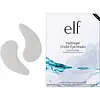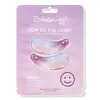What's inside
What's inside
 Key Ingredients
Key Ingredients

 Benefits
Benefits

 Concerns
Concerns

No concerns
 Ingredients Side-by-side
Ingredients Side-by-side

Water
Skin ConditioningButylene Glycol
HumectantGlycerin
HumectantCeratonia Siliqua Gum
EmollientSucrose
HumectantCeramide AP
Skin Conditioning1,2-Hexanediol
Skin ConditioningAgar
MaskingXanthan Gum
EmulsifyingChondrus Crispus
MaskingCellulose Gum
Emulsion StabilisingAllantoin
Skin ConditioningPEG-40 Hydrogenated Castor Oil
EmulsifyingHydroxyacetophenone
AntioxidantDisodium EDTA
Sodium Hydroxide
BufferingSyzygium Aqueum Fruit Water
Skin ConditioningNiacinamide
SmoothingGlycine Soja Seed Extract
Skin ConditioningSodium Hyaluronate
HumectantDipotassium Glycyrrhizate
HumectantHydroxyethylcellulose
Emulsion StabilisingAcrylates/C10-30 Alkyl Acrylate Crosspolymer
Emulsion StabilisingPEG/PPG-17/6 Copolymer
SolventPolyacrylic Acid
Emulsion StabilisingParfum
MaskingWater, Butylene Glycol, Glycerin, Ceratonia Siliqua Gum, Sucrose, Ceramide AP, 1,2-Hexanediol, Agar, Xanthan Gum, Chondrus Crispus, Cellulose Gum, Allantoin, PEG-40 Hydrogenated Castor Oil, Hydroxyacetophenone, Disodium EDTA, Sodium Hydroxide, Syzygium Aqueum Fruit Water, Niacinamide, Glycine Soja Seed Extract, Sodium Hyaluronate, Dipotassium Glycyrrhizate, Hydroxyethylcellulose, Acrylates/C10-30 Alkyl Acrylate Crosspolymer, PEG/PPG-17/6 Copolymer, Polyacrylic Acid, Parfum
Water
Skin ConditioningGlycerin
HumectantMethylpropanediol
SolventChondrus Crispus Extract
Skin Conditioning1,2-Hexanediol
Skin ConditioningCeratonia Siliqua Gum
EmollientSimmondsia Chinensis Seed Oil
EmollientTremella Fuciformis Extract
HumectantSodium Hyaluronate
HumectantAscorbic Acid
AntioxidantArtemisia Capillaris Extract
Chamaecyparis Obtusa Leaf Extract
Skin ConditioningCentella Asiatica Leaf Extract
Skin ConditioningMelaleuca Alternifolia Leaf Extract
PerfumingUlmus Davidiana Root Extract
Skin ConditioningGlucomannan
Skin ConditioningPolysorbate 20
EmulsifyingXanthan Gum
EmulsifyingPEG-60 Hydrogenated Castor Oil
EmulsifyingDextrin
AbsorbentDisodium EDTA
Sodium Hydroxide
BufferingWater, Glycerin, Methylpropanediol, Chondrus Crispus Extract, 1,2-Hexanediol, Ceratonia Siliqua Gum, Simmondsia Chinensis Seed Oil, Tremella Fuciformis Extract, Sodium Hyaluronate, Ascorbic Acid, Artemisia Capillaris Extract, Chamaecyparis Obtusa Leaf Extract, Centella Asiatica Leaf Extract, Melaleuca Alternifolia Leaf Extract, Ulmus Davidiana Root Extract, Glucomannan, Polysorbate 20, Xanthan Gum, PEG-60 Hydrogenated Castor Oil, Dextrin, Disodium EDTA, Sodium Hydroxide
Ingredients Explained
These ingredients are found in both products.
Ingredients higher up in an ingredient list are typically present in a larger amount.
1,2-Hexanediol is a synthetic liquid and another multi-functional powerhouse.
It is a:
- Humectant, drawing moisture into the skin
- Emollient, helping to soften skin
- Solvent, dispersing and stabilizing formulas
- Preservative booster, enhancing the antimicrobial activity of other preservatives
Ceratonia Siliqua Gum is extracted from the seeds of the carob tree. You might know this ingredient as Carob Gum or Locust Bean Gum. It is used to stabilize other ingredients and improve the texture of products.
Carob gum is made up of long-chain polysaccharides. This makes it a natural thickener.
Yes! This ingredient comes from the seeds of a tree. The name 'Locust Bean Gum' can be misleading.
Learn more about Ceratonia Siliqua GumDisodium EDTA plays a role in making products more stable by aiding other preservatives.
It is a chelating agent, meaning it neutralizes metal ions that may be found in a product.
Disodium EDTA is a salt of edetic acid and is found to be safe in cosmetic ingredients.
Learn more about Disodium EDTAGlycerin is already naturally found in your skin. It helps moisturize and protect your skin.
A study from 2016 found glycerin to be more effective as a humectant than AHAs and hyaluronic acid.
As a humectant, it helps the skin stay hydrated by pulling moisture to your skin. The low molecular weight of glycerin allows it to pull moisture into the deeper layers of your skin.
Hydrated skin improves your skin barrier; Your skin barrier helps protect against irritants and bacteria.
Glycerin has also been found to have antimicrobial and antiviral properties. Due to these properties, glycerin is often used in wound and burn treatments.
In cosmetics, glycerin is usually derived from plants such as soybean or palm. However, it can also be sourced from animals, such as tallow or animal fat.
This ingredient is organic, colorless, odorless, and non-toxic.
Glycerin is the name for this ingredient in American English. British English uses Glycerol/Glycerine.
Learn more about GlycerinSodium Hyaluronate is hyaluronic acid's salt form. It is commonly derived from the sodium salt of hyaluronic acid.
Like hyaluronic acid, it is great at holding water and acts as a humectant. This makes it a great skin hydrating ingredient.
Sodium Hyaluronate is naturally occurring in our bodies and is mostly found in eye fluid and joints.
These are some other common types of Hyaluronic Acid:
Learn more about Sodium HyaluronateSodium Hydroxide is also known as lye or caustic soda. It is used to adjust the pH of products; many ingredients require a specific pH to be effective.
In small amounts, sodium hydroxide is considered safe to use. However, large amounts may cause chemical burns due to its high alkaline.
Your skin has a natural pH and acid mantle. This acid mantle helps prevent harmful bacteria from breaking through. The acid mantle also helps keep your skin hydrated.
"Alkaline" refers to a high pH level. A low pH level would be considered acidic.
Learn more about Sodium HydroxideWater. It's the most common cosmetic ingredient of all. You'll usually see it at the top of ingredient lists, meaning that it makes up the largest part of the product.
So why is it so popular? Water most often acts as a solvent - this means that it helps dissolve other ingredients into the formulation.
You'll also recognize water as that liquid we all need to stay alive. If you see this, drink a glass of water. Stay hydrated!
Learn more about WaterXanthan gum is used as a stabilizer and thickener within cosmetic products. It helps give products a sticky, thick feeling - preventing them from being too runny.
On the technical side of things, xanthan gum is a polysaccharide - a combination consisting of multiple sugar molecules bonded together.
Xanthan gum is a pretty common and great ingredient. It is a natural, non-toxic, non-irritating ingredient that is also commonly used in food products.
Learn more about Xanthan Gum